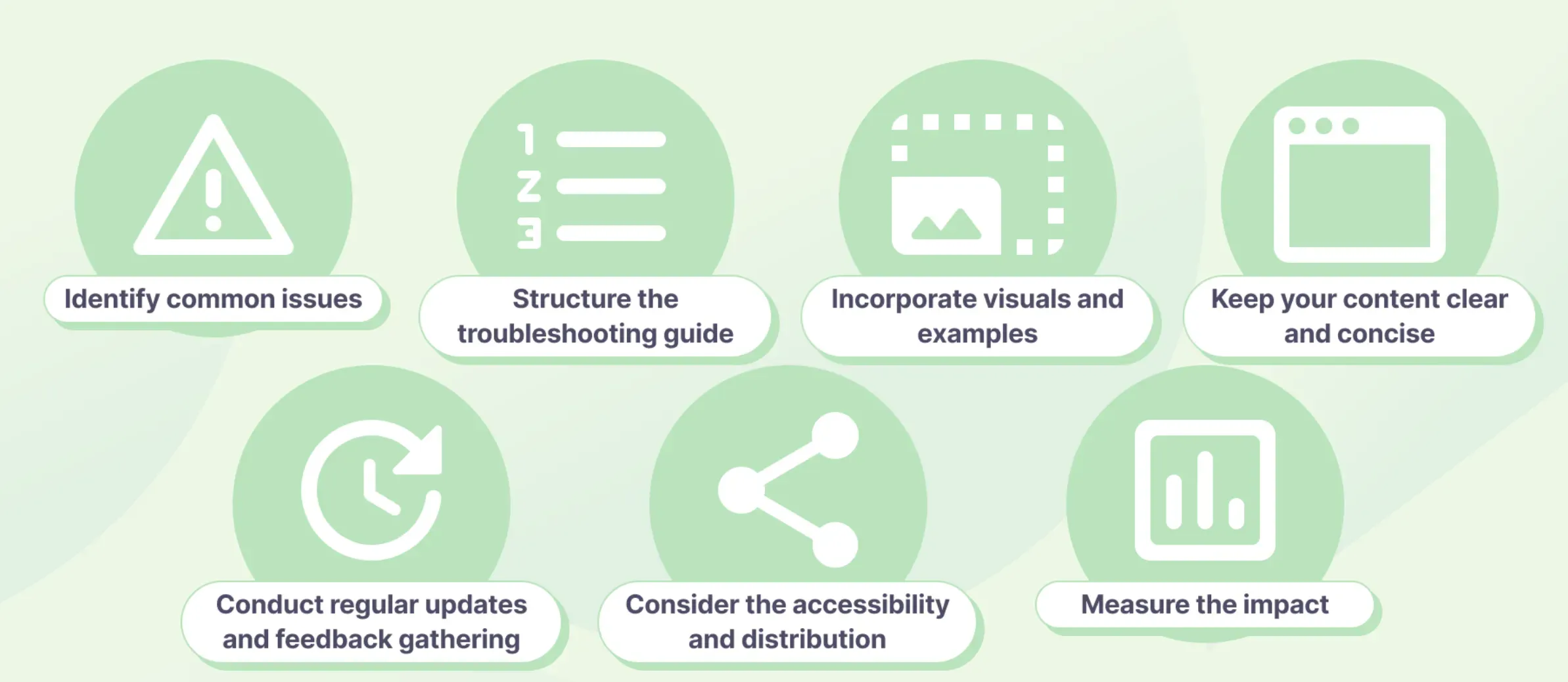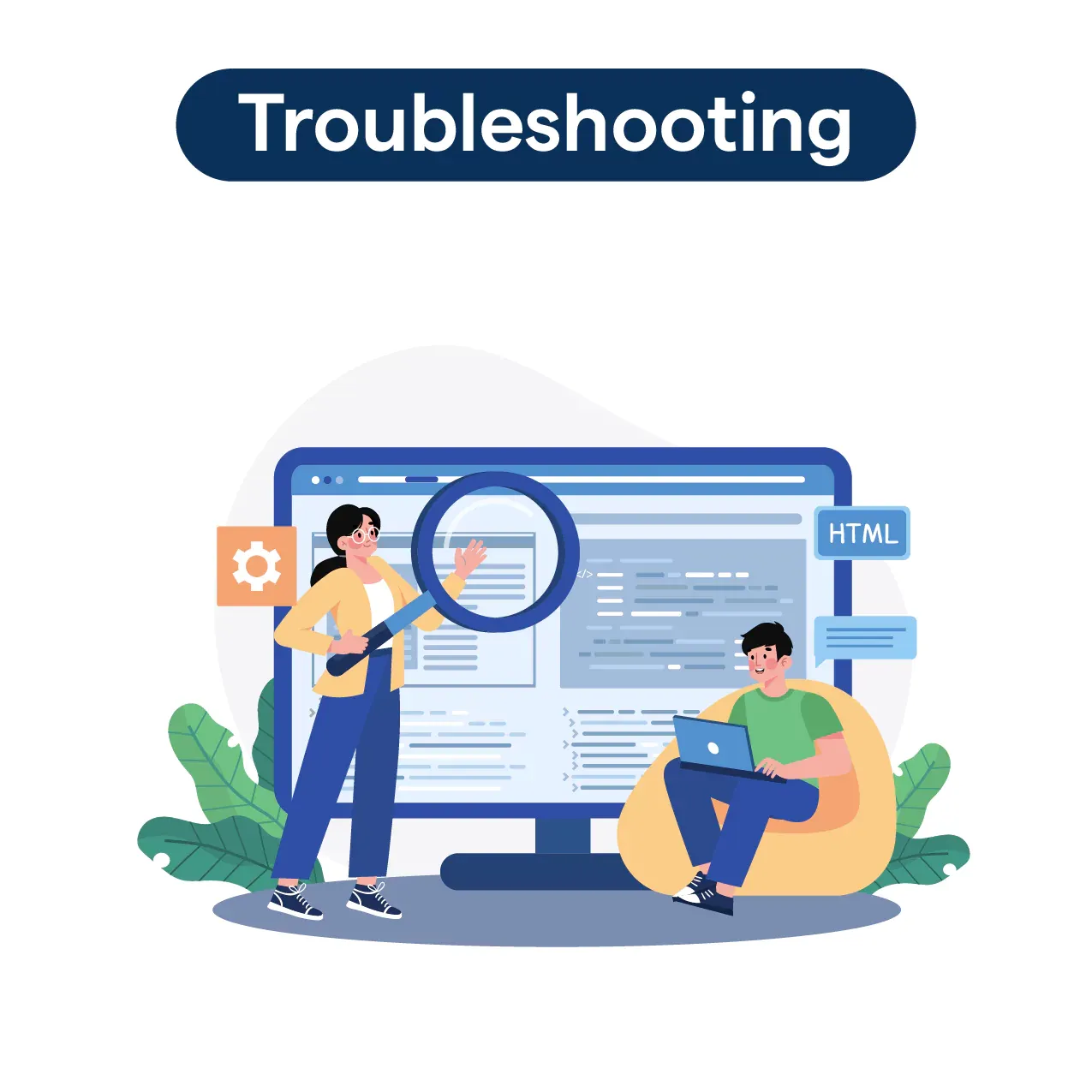What is Troubleshooting?
Troubleshooting is a problem-solving process that aims to identify and resolve issues in a systematic manner. It is commonly used in customer service to address technical problems faced by customers. Troubleshooting involves a series of steps to diagnose and fix issues efficiently.
Why is Troubleshooting Important in Customer Service?

The Role of Troubleshooting in Resolving Customer Issues
Troubleshooting is crucial in customer service as it enables support teams to quickly identify the root cause of problems and provide appropriate solutions.
It helps address customer concerns, leading to customer satisfaction and retention.
Effective troubleshooting ensures a positive customer experience.
Preventive Aspect of Troubleshooting to Avoid Future Problems
Troubleshooting not only resolves current issues but also helps prevent similar problems in the future.
By analyzing the causes of problems and implementing preventive measures, troubleshooting helps businesses identify recurring issues and take proactive steps to avoid them.
This reduces the impact of future problems on customers and operations.
Key Components of a Troubleshooting Process

Step 1
Identify the Problem
To effectively troubleshoot, it is crucial to accurately identify the problem. This involves gathering information about the symptoms and error messages reported by the customer.
It also includes defining the problem clearly to understand its scope and impact.
Step 2
Gather Information
In this step, support teams collect relevant details about the issue. They may ask customers specific questions to gather additional information and understand the context.
It may involve collecting information about recent changes made to the system, product specifications, and any error codes or messages encountered.
Step 3
Analyze the Information
After gathering the necessary information, the next step is to analyze it. Support teams identify patterns, factors, and potential causes contributing to the problem.
Through careful analysis, they narrow down the possible root causes of the issue.
Step 4
Develop a Hypothesis
Based on the analysis of the information, support teams develop a hypothesis.
This is a testable explanation of what may be causing the problem. The hypothesis should be based on logical reasoning and prioritize the most likely cause.
Step 5
Test the Hypothesis
Support teams implement corrective actions based on the developed hypothesis.
This involves making changes, adjustments, or repairs to address the suspected cause of the problem. They then observe and analyze the results of these actions.
Step 6
Resolve the Problem
Once the correct cause of the problem is identified, support teams implement the solution.
This may involve replacing faulty components, adjusting settings, reinstalling software, or performing repairs. The goal is to resolve the problem and restore normal functionality.
Step 7
Verify the Solution
After implementing the solution, support teams conduct tests to verify that the problem has been properly resolved.
They check if the issue no longer occurs and if the system or product functions as expected.
Verification ensures that the solution was effective and confirms that the problem has been successfully addressed.
Step 8
Document the Solution
Documentation is a crucial step in the troubleshooting process. Support teams should document the steps taken, the identified cause, and the solution implemented.
This helps create a knowledge base that can be used for future reference and training.
Documenting the solution ensures that the troubleshooting process is repeatable and allows other team members to benefit from the knowledge gained.
Step 9
Prevent the Problem from Recurring
To avoid similar issues in the future, support teams should take preventive actions.
This may include updating software regularly, improving maintenance procedures, providing user education and training, or implementing system enhancements.
Preventive measures are crucial to minimize the chances of recurring problems and improve the overall stability and reliability of the system or product.
Step 10
Follow up and Customer Satisfaction
After resolving the problem, it is essential to follow up with the customer to ensure their satisfaction.
Support teams should check if the issue has been completely addressed and confirm that the customer is now satisfied with the solution.
This step helps maintain a positive customer relationship and provides an opportunity for feedback to improve the troubleshooting process.
Common Troubleshooting Challenges
Troubleshooting is an integral part of the technological landscape. However, just like any process, it has its challenges. Let's delve into the most common ones experienced during troubleshooting.

Identifying the Root Cause
Perhaps the most critical challenge is pinpointing the root cause of a problem. With complex and interconnected systems, it could be tough to identify where exactly the problem originated.
- Complex Systems: Systems often comprise multiple components interacting and depending on each other, which can make isolating the cause of an issue difficult.
- Intermittent Issues: These are issues that happen sporadically, making it extremely challenging to diagnose.
- Symptom vs. Problem: Often, what appears to be the issue is merely a symptom of a deeper, underlying problem.
- Log Analysis: Tracing through logs and identifying relevant information in a sea of data can be tedious.
Implementing the Right Solution
Once a problem is identified, knowing how to fix it properly can be equally befuddling.
- Knowledge Gap: Potential solutions require specific knowledge, and lack thereof can hinder corrective efforts.
- Compatibility Issues: A solution may appear ideal but can cause compatibility issues with other system components.
- Resource Constraints: Addressing an issue might need resources, like time, equipment, or skills, which might not be readily available.
- Testing and Verification: After applying a solution, adequately testing and verifying it may require significant effort and expertise.
Communication Challenges
Addressing troubleshooting issues often necessitates dialogue with multiple parties - users, colleagues, or manufacturers. Effective communication is essential but not always easy.
- Technical Jargon: Difficulty explaining technical issues to non-technical users or, conversely, decoding user complaints into tangible technical problems.
- User Cooperation: Depending on the issue, user cooperation may be necessary, which could potentially be challenging.
- Coordination with Teams: Involving multiple teams or specialists might lead to communication gaps or lack of coordination.
- Information Gathering: Collecting accurate, detailed, and useful information about the problem can often be challenging.
Time and Resource Limitations
Time and resource constraints often lead to added pressure and complexity in the troubleshooting process.
- Time Sensitive Issues: Some problems cause significant operational downtime and need urgent attention.
- Prioritization: When multiple issues arise simultaneously, deciding which problems to address first.
- Budget Constraints: Limited budget might hinder the troubleshooting process, may be in terms of acquiring necessary tools or hiring professionals.
- Resource Allocation: Determining how much time and resources to devote to a problem can be tough, especially with restricted resources.
Common Tools for Troubleshooting
Having the right tools can make solving technological issues significantly more manageable. Here are some commonly used tools in troubleshooting.
Diagnostic Tools
A go-to for most troubleshooters, diagnostic tools help in detecting and diagnosing issues within a system.
- Event Viewers: Help review system logs to identify the cause of specific issues.
- Performance Monitors: Allows ongoing monitoring of system resources to detect performance issues in real-time.
- System Diagnostic Reports: Provides comprehensive information about system configuration, performance, and problems.
- System Information Tools: Provide in-depth details about system hardware, aiding in troubleshooting hardware-related problems.
Network Troubleshooting Tools
Network troubleshooting requires specific tools to test connectivity and diagnose network-related issues.
- Ping and Traceroute: Fundamental network diagnostic utilities that test connectivity to a particular network host.
- Wireshark: A network protocol analyzer tool, useful in analyzing packets in your network.
- Netstat: A command-line tool that provides information about network connections, routing tables, and interface statistics.
- Speed Test Tools: Popular for assessing the quality of your internet connection by measuring upload, download speeds, and latency.
Hardware Troubleshooting Tools
For fixing hardware issues, there are a few tools you might find in a troubleshooter's kit.
- Multimeter: For diagnosing problems in electronic devices by measuring voltage, current, and resistance.
- Cable Testers: Devices that check for signal strength, connectivity issues, and cable integrity.
- Power Supply Testers: As the name suggests, they test the health of a system's power supply.
- Hardware Diagnostic Software: Many hardware manufacturers provide their software to test their hardware components.
Software Troubleshooting Tools
Software issues have their unique troubleshooting tools that aid in speedily solving problems.
- Debugger: Essential tool for program development and troubleshooting, for finding and fixing coding mistakes.
- Logging and Monitoring Tools: Help in identifying anomalies in software processes and outputs.
- Profiling Tools: These measure things like memory use and identify performance bottlenecks in code.
- Automated Testing Tools: Simulate user interaction and identify errors in software applications.
How to Approach Troubleshooting Today
Approaches and methodologies evolve with technology. Let's learn how to approach troubleshooting in today's increasingly complex and interconnected technological landscape.

Adopting a Systematic Approach
A systematic approach to troubleshooting ensures accuracy and efficiency.
- Defining the Problem: Gather information, replicate the problem, and check error codes or logs.
- Planning the Approach: Organize tasks, decide on tools and techniques, and set expectations.
- Repairing and Testing: Applying fixes and comprehensively testing them to ensure the problem is resolved.
- Documenting the Process: Record the issue, the resolution, and the steps followed for future reference.
Leveraging Automation
Automation is revolutionizing all fields, including troubleshooting. Grab this fast-approaching transformation to make your troubleshooting more efficient.
- Automated Diagnostic Tools: Using tools that can automatically diagnose and sometimes even repair flaws in a system.
- Bug Reporting Systems: Deploying systems that automatically report bugs as they occur.
- Automated Test Frameworks: Using tools to automate testing and verify that the changes made during troubleshooting are working as intended.
- AI-driven Troubleshooting: Using AI algorithms and machine learning models can predict and prevent issues before they arise.
Emphasizing Preventive Measures
Proactive troubleshooting is proving better than reactive troubleshooting. The focus is shifting towards preventing issues before they happen.
- Routine Maintenance: Regular maintenance of systems can help identify and resolve issues before they culminate into bigger problems.
- Updating and Patching Regularly: Regular software updates and patches often include bug fixes and preventive measures, reducing the likelihood of issues occurring.
- Network Monitoring: Regular monitoring of networks can prevent many networking issues, as it allows for timely detection and resolution of network anomalies.
- Regular Backups: It secures your data and helps in recovering swiftly from significant failures or catastrophes.
Refreshing Skills and Knowledge Regularly
The world of technology is perpetually evolving; thus, updating your knowledge base is imperative for successful troubleshooting.
- Continuous Learning: Regularly update your knowledge to maximize troubleshooting efficiency in the newest technologies.
- Training and Certification: Pursue relevant training and certifications to keep abreast with the latest troubleshooting tools and techniques.
- Peer Collaboration: Collaborate with peers to share knowledge, learn about new issues, and discuss potential solutions.
- Stay Informed: Follow blogs, newsletters, and forums to stay apprised of the latest updates and trends in technology troubleshooting.
Frequently Asked Questions (FAQs)
How do I identify a problem during troubleshooting?
Gather information from customers, ask specific questions and carefully analyze the symptoms and error messages reported to accurately identify the problem.
How can I prevent similar problems in the future during troubleshooting?
By analyzing the root cause of the problem, taking preventive measures such as regular software updates, implementing system enhancements or improving maintenance procedures can prevent similar issues.
What are common challenges faced during troubleshooting?
Common challenges include software bugs, user errors or misuse of features, integration issues, network problems, and security breaches or vulnerabilities.
What is the importance of documenting during troubleshooting?
Documentation of the troubleshooting process helps create a knowledge base for future reference, identify recurring issues, and train other team members.
How can modern technologies help during troubleshooting?
Modern technologies such as remote diagnostics, machine learning, and artificial intelligence can assist in the troubleshooting process, enabling support teams to efficiently diagnose and resolve issues.


